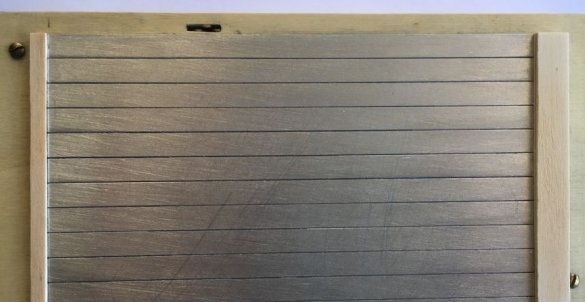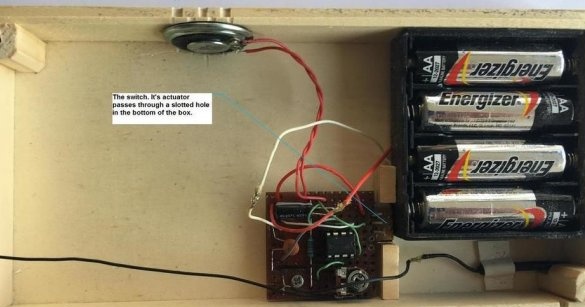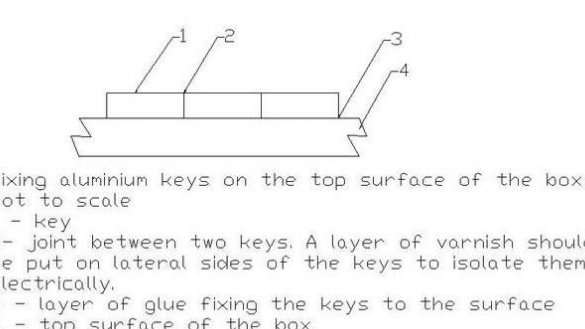Under the nickname Alex Kov, the author of Instructables was tired of the same toy synthesizers, differing only in cases, and he decided to give the little son an original Christmas electronic musical instrument. Having studied what they are, he became interested in the stylophone and decided to do something similar. The master came up with his own keyboard design for him, consisting of the same elongated pads. You can play like on an ordinary stylophone, or you can write letters, numbers with a stylus, and each of them will have a unique musical pattern. It will be more interesting to teach them to a child, and there, you look, and homemade will be interested as a folder.
The musical instrument is based on a generator on a 555 timer chip (KR1006VI1):

The frequency of oscillations generated by such a generator does not depend on the supply voltage, and is determined only by the values of resistors and capacitors according to the formula:
f = 1.44 / (R1 + 2 * R2) * C1
The variable here is the resistance of the resistor chain R2 + R3 + R4 ..., denoted in the equation as R2 and depending on the position of the stylus. To calculate its value for each of the twelve notes, the master transformed this formula as follows:
R2 = 1/2 * {1.44 / (f * C1) - R1}
The dimensions of the tool body are 198x98x31 mm, which means that 12 pads will fit 7 mm wide each - they will occupy 84 mm, and there will still be 7 mm from each side. The range is from “to sharp” of the fifth octave to “to” the sixth. There he is:
To the sharp fifth octave - 554.37 Hz
Re - // - - 587.33 Hz
Sharp - // - - 622.25 Hz
Mi - // - - 659.25 Hz
Fa - // - - 698.46 Hz
F Sharp - // - - 739.99 Hz
Salt - // - - 783.99 Hz
Salt Sharp - // - - 830.61 Hz
La - // - - 880.00 Hz
A sharp - // - - 932.33 Hz
C - // - - 987.77 Hz
Up to the sixth octave - 1046.50 Hz
Taking the resistor R1 by 10 kOhm and the capacitor C1 by 100 nF, Alex Kov substituted the corresponding values in the formula together with the frequency of the last note - 1046.50 Hz, and got R2 = 1876 Ohms. He also calculated the total resistance of the chain for the rest of the notes, and the denominations of all the resistors of which the chain consists, then received a simple subtraction, and then led to the standard series.
Do you want to count, or at least somehow automate the calculation? Then, as once, when doing homework, adjust to the answer: R2 = 1876 Ohm, R3 = 411 Ohm, R4 = 438 Ohm, R5 = 456 Ohm, R6 = 482 Ohm, R7 = 520 Ohm, R8 = 546 Ohm, R9 = 570 Ohms, R10 = 626 Ohms, R11 = 650 Ohms, R12 = 690 Ohms, R13 = 730 Ohms, you can easily choose the closest values from the standard range yourself.
What the homemade product looks like from above, you have already seen, now look at it from the side and from the inside:
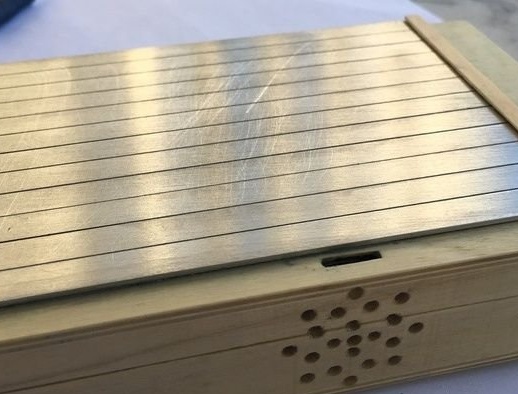
The top cover on the back, the bar with resistors is visible:
Fixing pads in three projections (scale not met):
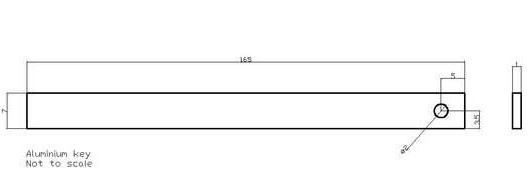
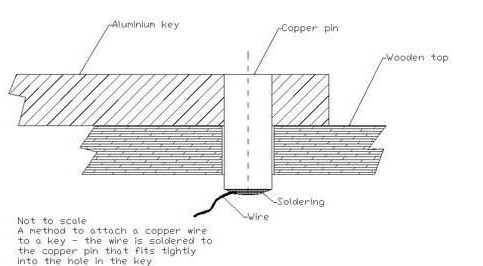
Here 1 is a contact pad, 2 is a layer of insulating varnish, 3 is a layer of glue, 4 is a body. To connect the wire to the contact pad, it must be soldered to a tinned copper pin, which is then inserted with force into the hole in the contact pad through a wider hole in the housing. A tinned pin is not suitable, since the connection of copper with aluminum is directly unacceptable. There should not be a chamfer at the contact pads so that the stylus easily moves from one contact pad to another for playing legato, if this name is generally applicable to one-voice music.
The stylus is made of a fountain pen, the contact is taken from an old power plug. The master soldered a thin wire to it, then fixed the contact with transparent glue. The thin wire was soldered to the thick end with the other end and also fixed. It is important that the contact is rounded, otherwise it will scratch the pads.
So you can play the instrument and make sound portraits of letters and numbers through templates:
Speaking of homework. Here she is. You decided to expand the range of this thing to two octaves, without increasing the number of pads, and taking two parts for this: a button and an additional resistor, which it closes. Calculate the resistance of this resistor.

